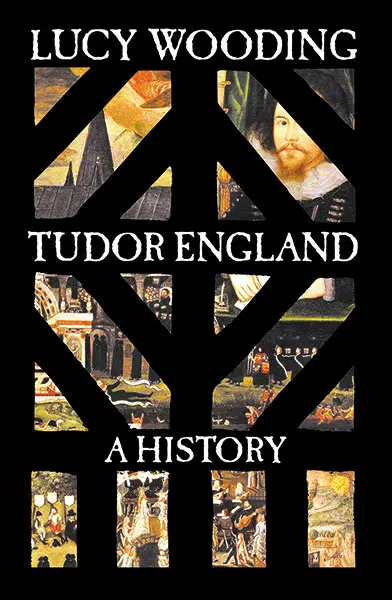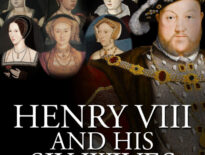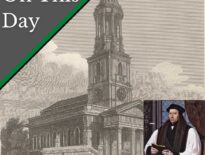Lucy Wooding is the Langford fellow and tutor in history at Lincoln College, Oxford. She is an expert on Reformation England and its politics, religion, and culture and the author of Henry VIII. She has asked us to share this section from her book "Tudor England: A History".
You can get the book at THIS LINK
 As the tensions of the later sixteenth century, both religious and political, became more acute, Tudor drama itself became more sophisticated, and more heavily freighted with meaning. Elizabethan plays might have a dangerously polemical edge, or a blunt propaganda purpose. Where fifteenth-century plays had often conveyed a religious message, later Tudor drama continued to explore moral dilemmas, albeit with a level of self-conscious wariness that earlier dramas had lacked. Solely religious plays became a thing of the past in the fraught confessional climate of the 1580s and 1590s, but drama became, if anything, more pervasive1. Plays, or ‘playings’, took place at Court, in private households, in the universities and Inns of Court, in taverns and inns, in the market square or through the streets of a city on May Day or to celebrate midsummer. By the end of the sixteenth century, there were also commercial theatrical spaces akin to the modern theatre; the first of these was built by James Burbage in Shoreditch in 1576, and called simply the Theatre2. South of the river, Philip Henslowe built the Rose on Bankside in 1587, and it was joined in 1595 by the Swan and in 1599 by the Globe. Yet even in the age of Shakespeare, theatre still belonged as much in the street or the household as upon a stage.
As the tensions of the later sixteenth century, both religious and political, became more acute, Tudor drama itself became more sophisticated, and more heavily freighted with meaning. Elizabethan plays might have a dangerously polemical edge, or a blunt propaganda purpose. Where fifteenth-century plays had often conveyed a religious message, later Tudor drama continued to explore moral dilemmas, albeit with a level of self-conscious wariness that earlier dramas had lacked. Solely religious plays became a thing of the past in the fraught confessional climate of the 1580s and 1590s, but drama became, if anything, more pervasive1. Plays, or ‘playings’, took place at Court, in private households, in the universities and Inns of Court, in taverns and inns, in the market square or through the streets of a city on May Day or to celebrate midsummer. By the end of the sixteenth century, there were also commercial theatrical spaces akin to the modern theatre; the first of these was built by James Burbage in Shoreditch in 1576, and called simply the Theatre2. South of the river, Philip Henslowe built the Rose on Bankside in 1587, and it was joined in 1595 by the Swan and in 1599 by the Globe. Yet even in the age of Shakespeare, theatre still belonged as much in the street or the household as upon a stage.
Drama was not just a source of entertainment or moral commentary: it was proactive in the shaping of affairs and attitudes. In an age when institutions were still flimsy, and politics were intensely personal, power could be confirmed or qualified through magnificence and display. The commonwealth, or state, was something imagined, but still it elicited an emotional investment given immediacy through symbolism3. Each display of power required a response, and each enactment of authority called for an answer, so drama was also a site for negotiation and the exchange of ideas in this ‘theatre state’4. Royal processions, progresses and tournaments encapsulated important transactions between ruler and ruled; in council meetings, parliaments and royal audiences, confrontations were enacted in which policy was shaped by participants on both sides. Deaths on the scaffold required the speeches of those about to die to reinforce codes of honour and obedience, while subtle alterations to the formulaic expressions of penitence and obedience might equally convey protestations of innocence, or even defiance. The drive for religious conformity made martyrs of many whose extraordinary commitment led them willingly to play their parts in a terrible drama of death. In their sufferings could be seen either the moral might of a government staunchly opposing heresy, or conversely, a testimony to religious truth serving as a powerful reproach to a persecutory regime; it was for the audience to choose.
This was an age in which men and women often found it easiest to express their own identity by acting a part. Elizabeth I in her lifetime was cast by both herself and others in roles as various as the Old Testament heroine Deborah or the goddess Diana; as the mythical King Arthur or the historical Emperor Constantine. When she famously remarked to William Lambarde, keeper of the Tower, ‘know ye not I am Richard II?’, she was acknowledging her own questionable reputation as ruler in her twilight years; she was also signalling the broader principle that political meaning could be readily conveyed by mimesis5. Badgered by parliament to execute Mary Queen of Scots, she reminded them of the dangers of public scrutiny: ‘Princes, you know, stand upon stages so that their actions are viewed and beheld of all men; and I am sure my doings will come to the scanning of many fine wits, not only within the realm, but in foreign countries.’6 Henry VII, in just a single royal progress in 1486, had been variously depicted as Solomon, Noah, Jason, Isaac, Jacob, David, Scipio and Arthur – legendary figures, invoked at a time of dangerous political instability, when the sanction of past rulers, generals and prophets was badly needed.7
References
- Thomas Betteridge and Greg Walker, ‘Introduction’, in Thomas Betteridge and Greg Walker (eds), The Oxford Handbook of Tudor Drama (Oxford, 2012), 4–8, 11.
- William Ingram, The Business of Playing: The beginnings of the adult professional theater in Elizabethan England (Ithaca, NY, 1992).
- Michael Walzer, ‘On the role of symbolism in political thought’, Political Science Quarterly 82 (1987), 194–95.
- For the conception of the ‘theatre state’, see Clifford Geertz, Negara: The theatre state in nineteenth-century Bali (Princeton, NJ, 1980), also Clifford Geertz, ‘Centers, kings and charisma: Reflections on the symbolics of power’, in Joseph Ben-David and Terry Nicholas Clark (eds), Culture and Its Creators: Essays in Honor of Edward Shils (Chicago, IL, 1977), and Clifford Geertz, ‘Politics past, politics present’, in Clifford Geertz, The Interpretation of Cultures: Selected essays (second edition, New York, 2000), 327–41.
- Stephen Orgel, Spectacular Performances: Essays on theatre, imagery, books and selves in early modern England (Manchester, 2011), 7–35.
- Elizabeth I: Collected Works, 189.
- David Bevington, Tudor Drama and Politics (Cambridge, MA, 1968), 6; see also John C. Meagher, ‘The first progress of Henry VII’, Renaissance Drama 1 (1968), 45–73.



Leave a Reply